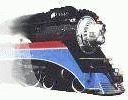Hallo. Gibt es eigentlich dokumentierte Angaben zur durchschnittlichen Reichweite eines Big Boys mit einer Ladung Kraftstoff(en)? Oder waren die Anforderungen (Gegebenheiten der Strecke, Gewicht der gezogenen Ladung) an die Maschinen zu weit gestreut sodass es keinen festen Wert gibt?
Grüße Seb

